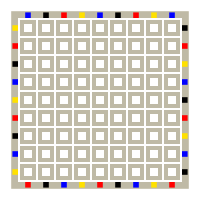Colomino
| Colomino | |
|---|---|
 Playing field with 9 × 9 fields for Colomino |
|
| Game data | |
| author | Max J. Kobbert |
| graphic | unknown |
| publishing company |
Ravensburger , Hallmark Games |
| Publishing year | 1973 |
| Art | Placement game |
| Teammates | 2 to 4 |
| Duration | 45 minutes |
| Age | from 9 years |
Colomino is a strategic placement game by the German game designer Max J. Kobbert , which appeared in the Ravensburger Casino series in 1973 and in the United States in 1976 under the name Block out by Hallmark Games . The game is based on the concept of dominoes , in that game pieces always have to be placed with their colored areas on matching stones. The players have to use square pieces to create a connection between two sides of a game board and get points by filling courtyards.
Style of play
Colomino is based on the classic domino . The players try to use the pieces available to lay a line on the game board from one baseline to the baseline on the opposite side and score as many points as possible. As with dominoes , you have to lay out the stones in such a way that neighboring colored areas match. The game material consists of a double-sided printed board with 9 × 9 and 12 × 12 playing fields, 144 square playing pieces with four colored areas each, 80 blue and yellow tokens each, four storage strips and a cloth bag.
Game flow
At the beginning of the game, the game board is placed between the players so that each player can access it from one side. Each player is given a storage bar, the game pieces are placed in the cloth bag. After a starting player has been determined, their baseline is set as the baseline for the round and the opposite side as the finish line. Each player blindly draws five tokens and places them on his filing board so that they cannot be seen by the other players.
The game is played in turn and the active player must choose three of his stones and place them on the stones already on display or on the baselines. Then he draws three tokens and puts them on his shelf. Inserted stones may no longer be relocated or removed. Each stone placed must be connected to the baseline either directly or by at least one side of stones that are already lying. As soon as the colored areas printed in the middle of the game board are connected to the baseline, this can also be applied to or appropriately placed on it. There are four white joker stones in the game that can be placed on any stone. If a player has a stone that fits in the place of a joker, he may place it on it.
Laying down the pieces creates open and closed “courtyards”. An open courtyard is an unoccupied square on the playing field that is surrounded on three sides with pieces and / or the baselines, and a closed courtyard is a field that is surrounded on all sides. A player who can place a token in an open courtyard receives a yellow color chip and a blue color chip for filling a closed courtyard. If a player can occupy several courts with his three chips in his turn, he receives the normal bonus for the first court, double the bonus for the second and triple the bonus for the third. A yard that is occupied by a joker stone can also be occupied and is rewarded accordingly. The yellow colored chip counts one point in the final scoring, the blue one two points.
The game ends when a player with a piece reaches the side opposite the baseline, after which each player can play one more move. The winner of the game is the player who has the most points at the end. In the event of a tie, the player with the most blue chips wins.
Expenses and reception
Colomino was developed by the German game designer Max J. Kobbert and was released in 1973 as the first published game in the Ravensburger Casino series . In 1976 it appeared on the American market in an English-language version under the name Block out by Hallmark Games .
supporting documents
- ↑ a b c d e f g Colomino - instructions
- ↑ Versions of Colomino in the BoardGameGeek database; Retrieved December 9, 2017.
Web links
- Colomino - game instructions
- Colomino in the board game database BoardGameGeek (English)
- Colomino in the Luding games database